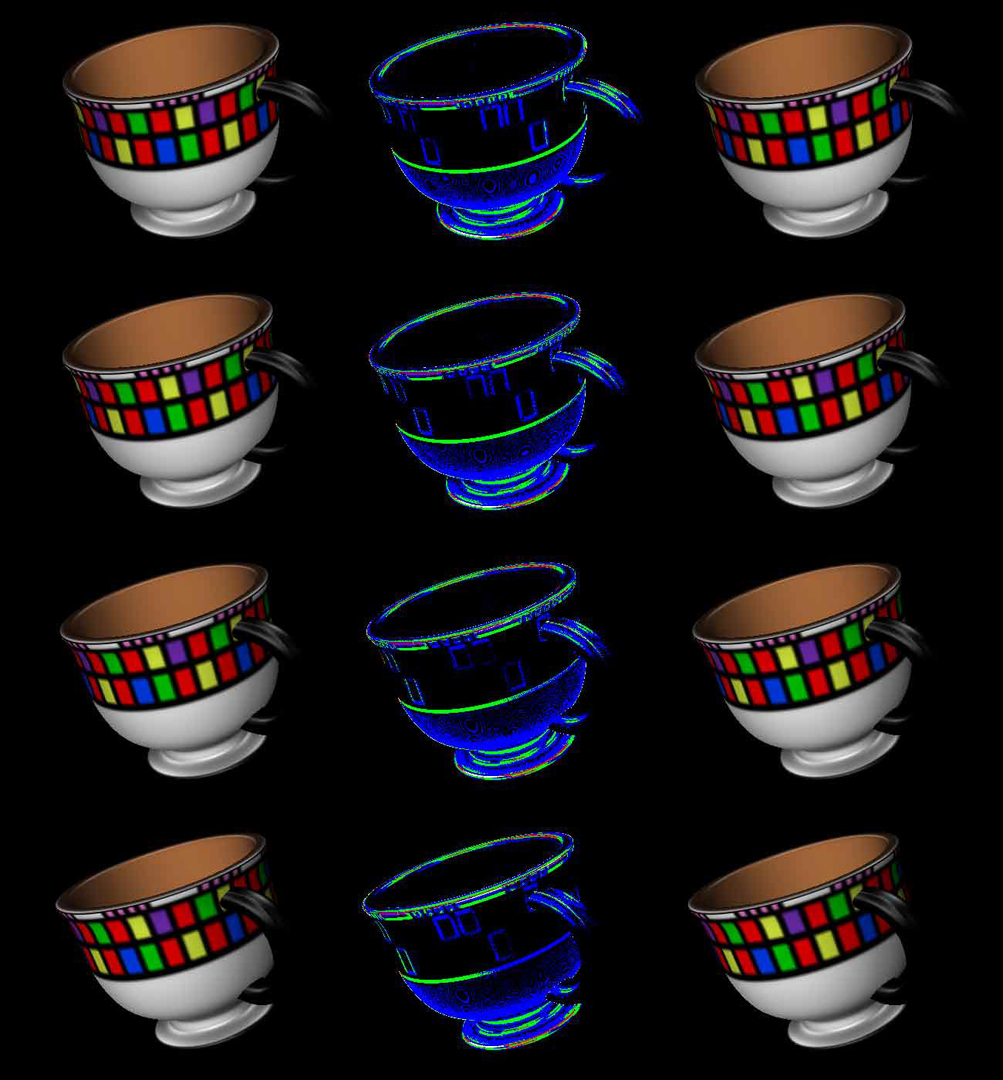“Multiple viewpoint rendering” by Halle
Conference:
Type(s):
Title:
- Multiple viewpoint rendering
Presenter(s)/Author(s):
Abstract:
This paper presents an algorithm for rendering a static scene from multiple perspectives. While most current computer graphics algorithms render scenes as they appear from a single viewpoint (the location of the camera) multiple viewpoint rendering (MVR) renders a scene from a range of spatially-varying viewpoints. By exploiting perspective coherence, MVR can produce a set of images orders of magnitude faster than conventional rendering methods. Images produced by MVR can be used as input to multiple-perspective displays such as holographic stereograms, lenticular sheet displays, and holographic video. MVR can also be used as a geometry-to-image prefilter for image-based rendering algorithms. MVR techniques are adapted from single viewpoint computer graphics algorithms and can be accelerated using existing hardware graphics subsystems. This paper describes the characteristics of MVR algorithms in general, along with the design, implementation, and applications of a particular MVR rendering system.
References:
1. Stephen J. Adelson, Jeffrey B. Bentley, In Seok Chung, Larry F. Hodges, and Joseph Winograd. Simultaneous Generation of Stereoscopic Views. Computer Graphics Forum, 10(1):3-10, March 1991.
2. Sig Badt, Jr. Two Algorithms for Taking Advantage of Temporal Coherence in Ray Tracing. The Visual Computer, 4(3):123-132, September 1988.
3. James F. Blinn.Jim Blinn’s corner: Hyperbolic Interpolation. IEEE Computer Graphics and Applications, 12(4):89-94, July 1992.
4. R. C. Bolles, H. H. Baker, and D. H. Marimont. Epipolar-Plane Image Analysis: An Approach to Determining Structure from Motion. Inter. J. Computer Vision, 1:7-55, 1987.
5. J. Chapman, T. W. Calvert, and J. Dill. Exploiting Temporal Coherence in Ray Tracing. In Proceedings of Graphics Interface ’90, pages 196-204, May 1990.
6. Shenchang Eric Chen and Lance Williams. View Interpolation for Image Synthesis. In James T. Kajiya, editor, Computer Graphics (SIGGRAPH 93 Proceedings), volume 27, pages 279-288, August 1993.
7. Michael Deering. Geometry Compression. In Robert Cook, editor, SIGGRAPH 95 Conference Proceedings, Annual Conference Series, pages 13-20, August 1995.
8. Steven J. Gortler, Radek Grzeszczuk, Richard Szeliski, and Michael F. Cohen. The Lumigraph. In Holly Rushmeier, editor, SIGGRAPH 96 Conference Proceedings, Annual Conference Series, pages 43-54, August 1996.
9. E. Groeller and W. Purgathofer. Using Temporal and Spatial Coherence for Accelerating the Calculation of Animation Sequences. In Werner Purgathofer, editor, Eurographics ’91, pages 103-113. North-Holland, September 1991.
10. Michael W. Halle. Autostereoscopic Displays and Computer Graphics. In Computer Graphics, ACM SIGGRAPH. 31(2), pages 58-62.
11. Michael W. Halle. The Generalized Holographic Stereogram. Master’s thesis, Department of Architecture and Planning, Massachusetts Institute of Technology, February 1991.
12. Michael W. Halle. Holographic Stereograms as Discrete Imaging Systems. In Practical Holography VIII, vol. 2176, pages 73- 84, SPIE, May 1994.
13. Michael W. Halle. Multiple Viewpoint Rendering for Autostereoscopic Displays. Ph.D. thesis, Media Arts and Sciences Section, Massachusetts Institute of Technology, May 1997.
14. Marc Levoy and Pat Hanrahan. Light Field Rendering. In Holly Rushmeier, editor, SIGGRAPH 96 Conference Proceedings, Annual Conference Series, pages 31-42, August 1996.
15. T. Okoshi. Three-Dimensional Imaging Techniques. Academic Press, New York, 1976.
16. Mark Segal, Carl Korobkin, Roll van Widenfelt, Jim Foran, and Paul E. Haeberli. Fast Shadows and Lighting Effects using Texture Mapping. In Edwin E. Catmull, editor, Computer Graphics (SIGGRAPH 92 Proceedings), volume 26, pages 249-252, July 1992.
17. Ivan E. Sutherland, Robert F. Sproull, and Robert A. Schumacker. A Characterization of Ten Hidden-Surface Algorithms. Computing Surveys, 6(1), March 1974.
18. S. Takahashi, T. Honda, M. Yamaguchi, N. Ohyama, and F. Iwata. Generation of Intermediate Parallax-images for Holographic stereograms. In Practical Holography VII.” Imaging and Materials, pages 2+, SPIE, 1993.
19. Jay Torborg and Jim Kajiya. Talisman: Commodity Real-time 3D Graphics for the PC. In Holly Rushmeier, editor, SIGGRAPH 96 Conference Proceedings, Annual Conference Series, pages 353- 364, August 1996.
20. Daniele Tost and Pere Brunet. A Definition of Frame-To- Frame Coherence. In N. Magnenat-Thalmann and D. Thalmann, editors, Computer Animation ’90, pages 207-225, April 1990.
21. Lance Williams. Pyramidal Parametrics. In Computer Graphics (SIGGRAPH ’83 Proceedings), volume 17, pages 1-11,July 1983.
22. Andrew Woo, Andrew Pearce, and Marc Ouellette. It’s Really Not a Rendering Bug, You See .. IEEE Computer Graphics and Applications, 16(5):21-25, September 1996.
23. Eric Zeghers, Kadi Bouatouch, Eric Maisel, and Christian Bouville. Faster Image Rendering in Animation Through Motion Compensated Interpolation. In Graphics, Design and Visualization, pages 49+. International Federation for Information Processing Transactions, 1993.





